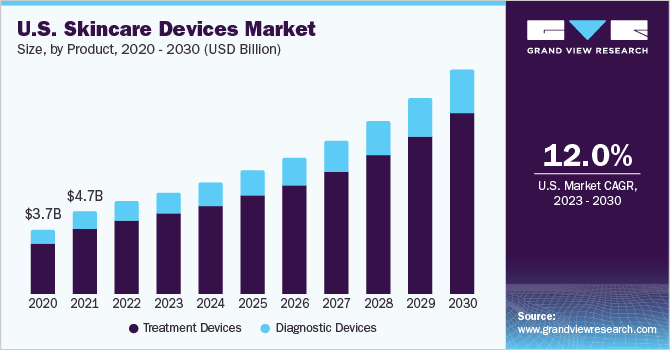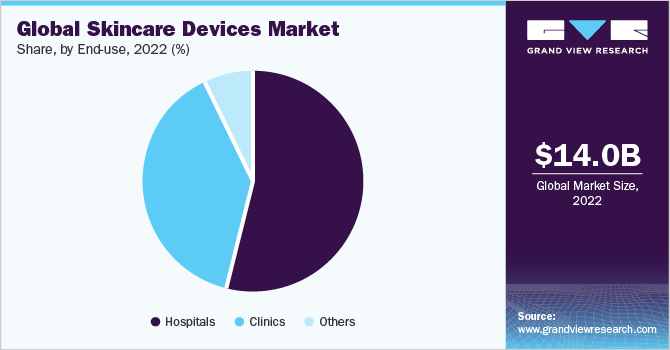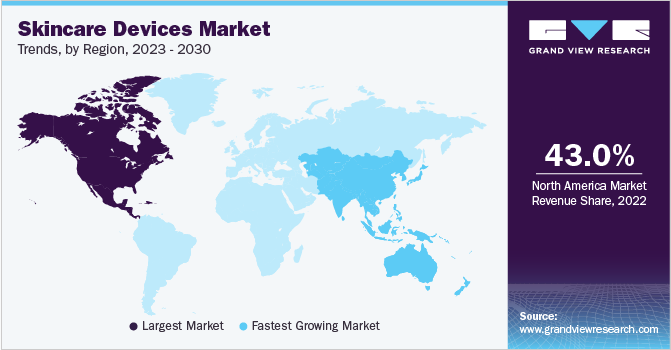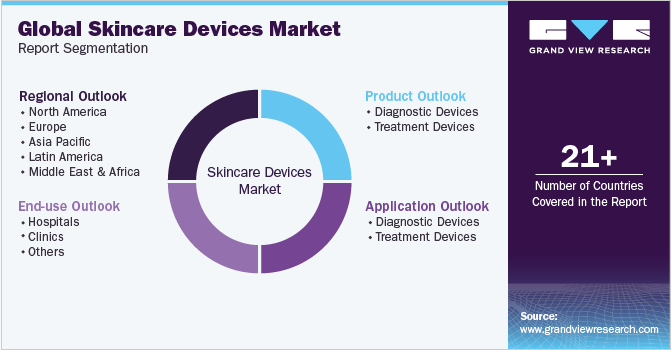- Home
- »
- Medical Devices
- »
-
Skincare Devices Market Size, Share & Growth Report, 2030GVR Report cover
![Skincare Devices Market Size, Share & Trends Report]()
Skincare Devices Market (2023 - 2030) Size, Share & Trends Analysis Report By Product, By Application (Diagnostic Devices, Treatment Devices,), By End-use, By Region, And Segment Forecasts
- Report ID: 978-1-68038-233-4
- Number of Report Pages: 120
- Format: PDF
- Historical Range: 2018 - 2021
- Forecast Period: 2023 - 2030
- Industry: Healthcare
- Report Summary
- Table of Contents
- Interactive Charts
- Methodology
- Download FREE Sample
-
Download Sample Report
Skincare Devices Market Summary
The global skincare devices market size was estimated at USD 13,994.5 million in 2022 and is projected to reach USD 34,337.9 million by 2030, growing at a CAGR of 11.9% from 2023 to 2030. The increasing prevalence of skin cancer and other skin diseases is contributing largely to the high demand for skincare devices.
Key Market Trends & Insights
- In terms of region, North America was the largest revenue generating market in 2022.
- Country-wise, Turkey is expected to register the highest CAGR from 2023 to 2030.
- In terms of segment, treatment devices accounted for a revenue of USD 11,140.2 million in 2022.
- Treatment devices is the most lucrative product segment, registering the fastest growth during the forecast period.
Market Size & Forecast
- 2022 Market Size: USD 13,994.5 Million
- 2030 Projected Market Size: USD 34,337.9 Million
- CAGR (2023-2030): 11.9%
- North America: Largest market in 2022
Furthermore, factors such as the increasing awareness and interest of people about the aesthetic appeal coupled with technological advancements in skincare devices and a rise in disposable income are also increasing the adoption of these devices significantly

The prevalence of skin cancer such as melanoma and non-melanoma skin cancers is growing significantly. According to the American Cancer Society, melanoma skin cancer accounts for only 1% of total skin cancer cases, however, it is responsible for the highest number of cancer deaths. It further suggests that approximately 97,610 more people are expected to be diagnosed with melanomas in 2023. Meanwhile, the American Academy of Dermatology (AAD) estimated that 1 in 3 Americans visit dermatologists, and 1 in every 4 are diagnosed with skin disease every year. This increases the need for rapid and efficient diagnostics devices to facilitate early diagnosis and treatment.
Another important driver for the skincare device market is the growing awareness regarding aesthetic appeals. In the present scenario, people from all age groups are interested in enhancing their aesthetic appeal, which can be facilitated through complete skin rejuvenation. This has led to the increasing use of technologically advanced products over conventional products that can assist in better diagnosis and treatment of skin diseases as well as improve one’s aesthetic appeal. Technological advancements in the field of skin care have also led to an increase in the market for skincare devices. People have gained confidence and started trusting such treatments. Improved laser therapy is one such advancement.
The COVID-19 pandemic significantly affected the market for skincare devices due to the lockdown and supply chain disruptions. Short-term negative growth was observed in the market due to the suspension of almost all non-COVID-19 related surgeries, limited operations of manufacturing, and disruption in the supply chain. With the successful rollout of vaccines in all regions, the volume of dermatological devices began to recover to its pre-pandemic levels. In 2021, the market witnessed high demand due to the backlog of surgeries from 2020 and increased interest from people related to dermatological procedures.
Product Insights
Based on product, the market is segmented into diagnostic devices and treatment devices. The treatment devices segment accounted for the largest revenue share of 79.6% in 2022 and is expected to grow at the highest CAGR of 12.5% over the forecast period. This is mainly due to the availability of wide applications of dermatology treatment. In addition, the launch of novel technologies in the laser device category is also attributed to the significant growth of the segment.
Among the treatment devices, the laser devices segment held the largest revenue share of 24.2% in 2022 and is expected to grow with the fastest CAGR of 14.0% over the forecast period. The use of lasers to treat cosmetic skin conditions such as acne, scars, and wrinkles is the major reason for the growth of this segment. The government and worldwide bodies around the world are now working to improve awareness among people about various skin problems.
Application Insights
Based on application, the market is segmented into treatments such as hair removal, skin rejuvenation, wrinkle removal and skin resurfacing, acne, psoriasis, and tattoo removal, body contouring and fat removal, cellulite reduction, and vascular and pigmented lesion removal. The hair removal application segment dominated the market for skincare devices and held the largest revenue share of about 16.1% in 2022. Hair removal devices, particularly, laser devices have been proven to be safer for all skin tones and hair colors and facilitate less painful treatment procedures, thereby fostering market growth.
A rise in demand for cosmetic laser treatments like tattoo removal, skin resurfacing, and skin tightening has significantly increased the adoption of dermatology devices. According to the International Society of Aesthetic Plastic Surgery, treatments like non-invasive fat reduction witnessed a 21.1% increase, laser hair removal witnessed a 76.1% increase and Photo Rejuvenation saw a 32.3% increase in 2020 as compared to 2019. This indicates that the demand for aesthetic treatments is increasing and this will directly impact the adoption of technologically advanced and efficient dermatology devices
The launch of new and technologically advanced products is further expected to boost the growth of this segment. For instance, in June 2022, Cynosure launched the Elite iQ platform in the U.S., Europe, and Australia. It is designed with patented Skintel technology that offers customized laser hair removal and skin revitalization treatments. Such treatments can encourage new customers to opt for skincare treatments and boost the market share.
The skin rejuvenation segment is expected to grow at the fastest CAGR of 14.3 % over the forecast period. People are becoming more concerned about their looks; and thus, treatments related to face and skin to appear more youthful are on the rise. This factor is anticipated to contribute to the growth of the segment in the forthcoming years.
End-use Insights
Based on end-use, the market is segmented into hospitals, clinics, and others. The hospital segment dominated the market and held the largest revenue of about 54.4% in 2022 owing to the presence of advanced skincare equipment in hospital settings. In addition, the availability of wide treatment options has also increased the number of visits for skin disease diagnosis and treatments in these facilities.

The clinic segment is anticipated to grow at the fastest CAGR of 13.2% over the forecast period from 2023 to 2030 owing to the increased number of clinics offering dermatology services across countries. Another driver for the growth of this segment is the lower cost of treatments in clinics compared to hospitals, which has led to an increase in the number of patients visiting clinics.In dermatology clinics, both surgical and nonsurgical services are offered by certified plastic surgeons. According to TripleTree, as of 2020, there were 9,000 dermatology practices and 14,000 dermatologists in the U.S. Among the total number of practices, 34.0% were solo practices and 48.0% of practices included three or more physicians.
Regional Insights
North America dominated the skincare devices market and accounted for the largest revenue share of 43.0% in 2022. The increasing prevalence of skin cancer and other skin diseases such as acne, rosacea, and eczema and the increasing adoption of different cosmetic procedures are some of the major factors contributing to the growth of the market in this region. According to the American Academy of Dermatology Association, acne is the most common skin condition in the U.S., affecting up to 50 million American citizens annually. Approximately 85% of people between the ages of 12 and 24 experience at least minor acne.

Asia Pacific is expected to grow at the fastest CAGR of 14.3% during the forecast period from 2023 to 2030 owing to the growth of medical tourism in the region. Advancements in medical technologies and the availability of affordable treatment options are expected to be major factors driving the growth of this market.Moreover, rising beauty consciousness amongst men and women is anticipated to further drive the regional market.
Key Companies & Market Share Insights
The key companies in the market are concentrating on strategic initiatives such as mergers and acquisitions, new product development, and geographical expansions. In October 2022, Promoitalia, a cosmetic product company announced the launch of iWave, which is a one-of-a-kind, body microwave contouring device. The device has shown safe and effective results in the process of fat reduction.
In November 2021, Lancer Skincare the premier Beverly Hills-based international skincare brand teamed up with the tech startup ByondXR to launch The Virtual Lancer Dermatology Shop. Lancer Skincare's new virtual store will provide customers with the in-home benefits of a Lancer dermatology practice through a curated, digital experience that moves across the newly growing digitized world. Some prominent players in the global skincare devices market include:
-
Alma Lasers GmbH
-
Cynosure, Inc.
-
Solta Medical, Inc.
-
Cutera, Inc.
-
Syneron Medical Ltd.
-
Canfield Scientific, Inc.
-
3Gen
-
Aesthetic Group
-
Ambicare Health
-
Image Derm, Inc.
-
Fotona
Skincare Devices Market Report Scope
Report Attribute
Details
Market size value in 2023
USD 15.3 billion
Revenue forecast in 2030
USD 34.3 billion
Growth rate
CAGR of 12.3% from 2023 to 2030
Base year for estimation
2022
Historical data
2018 - 2021
Forecast period
2023 - 2030
Report updated
September 2023
Quantitative units
Revenue in USD million/billion and CAGR from 2023 to 2030
Report coverage
Revenue forecast, company ranking, competitive landscape, growth factors, and trends
Segments covered
Product, application, end-use, region
Regional scope
North America; Europe; Asia Pacific; Latin America; MEA
Country scope
U.S.; Canada; U.K.; Germany; France; Italy; Spain; Denmark; Sweden; Norway; China; Japan; India; Australia; South Korea; Thailand; Brazil; Mexico; Argentina; South Africa; Saudi Arabia; UAE; Kuwait
Key companies profiled
Alma Lasers GmbH; Cynosure, Inc.; Solta Medical, Inc.; Cutera, Inc.; Syneron Medical Ltd.; Canfield Scientific, Inc.; 3Gen; Aesthetic Group; Ambicare Health; Image Derm, Inc.; Fotona
Customization scope
Free report customization (equivalent up to 8 analyst’s working days) with purchase. Addition or alteration to country, regional & segment scope
Pricing and purchase options
Avail customized purchase options to meet your exact research needs. Explore purchase options
Global Skincare Devices Market Report Segmentation
This report forecasts revenue growth at global, regional, and country levels and analyzes the latest industry trends in each sub-segment from 2018 to 2030. For this study, Grand View Research has segmented the global skincare devices market report based on product, application, end-use, and region:

-
Product Outlook (Revenue, USD Million, 2018 - 2030)
-
Diagnostic Devices
-
Dermatoscopes
-
Microscopes
-
Other Imaging Devices
-
Biopsy Devices
-
-
Treatment Devices
-
Light Therapy Devices
-
Lasers
-
Electrosurgical Equipment
-
Liposuction Devices
-
Microdermabrasion Devices
-
Cryotherapy Devices
-
-
-
Application Outlook (Revenue, USD Million, 2018 - 2030)
-
Diagnostic Devices
-
Skin Cancer Diagnosis
-
Other
-
-
Treatment Devices
-
Hair Removal
-
Skin Rejuvenation
-
Acne, Psoriasis, and Tattoo Removal
-
Wrinkle Removal and Skin Resurfacing
-
Body Contouring and Fat Removal
-
Cellulite Reduction
-
Vascular and Pigmented Lesion Removal
-
Others
-
-
-
End-use Outlook (Revenue, USD Million, 2018 - 2030)
-
Hospitals
-
Clinics
-
Others
-
-
Regional Outlook (Revenue, USD Million, 2018 - 2030)
-
North America
-
U.S.
-
Canada
-
-
Europe
-
U.K.
-
Germany
-
France
-
Italy
-
Spain
-
Denmark
-
Sweden
-
Norway
-
-
Asia Pacific
-
Japan
-
China
-
India
-
Australia
-
Thailand
-
South Korea
-
-
Latin America
-
Brazil
-
Mexico
-
Argentina
-
MEA
-
South Africa
-
Saudi Arabia
-
UAE
-
Kuwait
-
-
Frequently Asked Questions About This Report
b. The global skincare devices market size was estimated at USD 14.0 billion in 2022 and is expected to reach USD 15.3 billion in 2023.
b. The global skincare devices market is expected to grow at a compound annual growth rate of 12.3% from 2023 to 2030 to reach USD 34.3 billion by 2030.
b. North America dominated the skincare devices market with a share of 43.0% in 2022. This is attributable to rising healthcare awareness coupled with advanced technologies and constant research and development initiatives.
b. Some of the key players of the skincare devices market include Alma Lasers GmbH; Cynosure, Inc.; Solta Medical, Inc.; Cutera, Inc.; Syneron Medical Ltd.; Canfield Scientific, Inc.; 3Gen; Aesthetic Group; Ambicare Health; and Image Derm, Inc.
b. The increasing prevalence of skin cancer and other skin diseases is contributing largely to the high demand for the dermatology devices market.
Share this report with your colleague or friend.
Need a Tailored Report?
Customize this report to your needs — add regions, segments, or data points, with 20% free customization.

ISO 9001:2015 & 27001:2022 Certified
We are GDPR and CCPA compliant! Your transaction & personal information is safe and secure. For more details, please read our privacy policy.
Trusted market insights - try a free sample
See how our reports are structured and why industry leaders rely on Grand View Research. Get a free sample or ask us to tailor this report to your needs.










